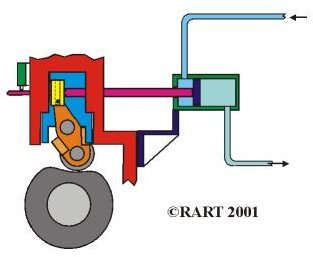How to reverse a marine engine?
Introduction
The propeller thrust must be reversible in order to do manoeuvring of a ship. Usually manoeuvring is done while entering a port or leaving a port. In case of a controllable pitch propeller an unidirectional engine is sufficient. In case of limited power systems like medium speed engines of high speed engines, clutches and reverse gears may be used. But in large diesel engines, the main engines must be reversible and should be able to produce thrust efficiently in both the directions ( ahead and astern )
To reverse an engine the engine cycle may require re-timing.
Large diesel engines have scavenge ports which controls the scavenge timing. This remains unchanged when reversed.
Engines working with constant pressure turbocharge systems also have symmetrical exhaust valve timing and hence no change in timing is required. Only the fuel timing to be changed since it will be the opposite flank of the cam.
In this article we shall discuss the different methods of reversing of marine diesel engines.
Reversing of old M.A.N engines:
In old M.A.N engines, the reversing procedure is carried out by means of shifting the camshaft axially. For this purpose a separate astern cam is fitted to the camshaft.
Each astern cam is fitted next to the corresponding ahead cam.
The whole camshaft can be shifted axially with the help of hydraulic cylinders fitted to the camshaft. The hydraulic oil gets pressurized and forces the piston inside the cylinder which moves the entire shaft from ahead to astern or from astern to ahead.
Locking devices and safety cutouts are fitted to that the correct positioning of the cam is achieved.
In some engines reversing is carried by the above same procedure. Only one change is that instead of hydraulic pressure, air pressure is used for shifting the camshaft axially.
Sulzer engines
Sulzer engines have lost-motion servomotors on the camshaft. These servomotors are useful to rotate the fuel pump cams to their astern positions. In RTA engines a servomotor is fitted in between a pair of adjacent cams.
Lost motion is a term which means the timing has been retarded by a certain angle with respect to the new direction of rotation.
M.A.N. B&W MC Engines
These engines have a separate method. In this method instead of shifting the entire camshaft, we are shifting the cam follower rollers to alter the timing. Compressed air from the starting system is used to actuate the pneumatic cylinder and piston which displaces each follower unit.
If the position is not properly locked in its place, the fuel delivery will be stopped. This is done by a sensor fitted to each pump.

These are some of the basic methods used for reversing of marine diesel engines which of course plays a vital role while manoeuvring.
Image Credits
www.marinediesels.info/Animations/MAN_B&W_reversing.gif - MAN MC ENGINES.
www.marinediesels.info/small_pictures/servomotor.gif - SERVOMOTOR
